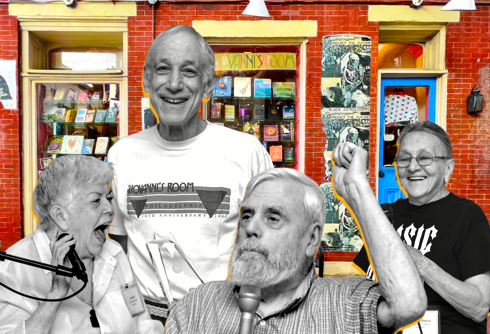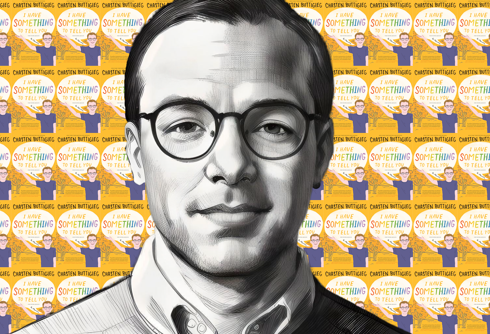Many queer authors have attempted to make sense of the AIDS epidemic by writing complex examinations of the politics behind the widespread devastation. Some of these groundbreaking books have become mainstays of college courses and modern queer thought, but it’s not all easy to explain the biggest ideas within them.
So we did the hard work of poring over these modern classics to present some of their most revolutionary ideas. Of course, our abbreviated versions can never replace the reading experience, but they may at least change the way you view HIV, queer activism, and your own power in a challenging world.
Related:
Here are 5 statistics that illustrate the current state of HIV in the US
There’s lots of good news, but the fight to end the epidemic continues…
AIDS and its Metaphors by Susan Sontag (1989)
Never Miss a Beat
Subscribe to our newsletter to stay ahead of the latest LGBTQ+ political news and insights.

What’s inside: In this bisexual cultural critic’s 1978 book Illness as Metaphor, Sontag pointed out that, in the popular imagination, tuberculosis was romanticized as a disease of creative excess, and cancer was seen as a disease of the emotionally repressed. Such metaphors don’t exist to comfort the sick, she wrote. They merely blame the sick for their own suffering and are ultimately authoritarian and dehumanizing, especially as politicians repeatedly declare war on any social scourge they regard as a “cancer” on the “body politic.”
In her 1989 follow-up, AIDS and Its Metaphors, she examines contemporary rhetoric about HIV and what it reveals about modern anxieties surrounding the global epidemic. Her academic analysis incorporates Western literature throughout history.
The impact: Sontag said AIDS turned the carefree, liberating world of sex — with its contraceptives and curable STIs — into an act with irreversible, dire social consequences. Because of its newness and lethality, Sontag doubted that AIDS would ever be romanticized. Indeed, AIDS was largely seen as the fault of “risk groups” whose “deviant” sex and drug use resulted in a self-inflicted death (even though “innocent” heterosexuals, hemophiliacs, and infants contracted it as well).
The tell-tale lesions and physical wasting of AIDS effectively outed the infected, often resulting in their eviction, firing, and expulsion from their families, communities, and even medical settings, bringing a “social death that precedes the physical one,” Sontag wrote. This created secrecy and suspicion around HIV, especially since someone could have it for years without any symptoms.
Why read now? Even though “HIV is no longer a death sentence” and “undetectable=untransmittable,” ignorance and stigma still surround HIV. Religious bigots still consider AIDS a Biblical plague that punished those most responsible for lowering society’s morals. Similar to COVID-19, racists pointed to AIDS’ foreign origin as proof of a “contamination” or “terrorist attack” from the “Third World.”
Ultimately, Sontag said that people’s perceptions of AIDS as an apocalyptic plague mirror social anxieties about the inability to control our future and also justify savage measures to control it. This all is particularly concerning since the planet now faces instability and possible annihilation from the unstable global economy, the nuclear arms race, and widespread environmental devastation.
The Gentrification of the Mind: Witness to a Lost Imagination by Sarah Schulman (2012)

What’s inside: Schulman observed that the Manhattan neighborhoods with the highest rate of AIDS deaths drastically increased the rents of their now-empty apartments — sometimes by 500% or more. The poor, ethnically diverse, socially marginalized queers, artists, and refugees who once lived there were replaced by white, affluent, sexually discreet professionals who established businesses for wealthier clientele.
This effectively erased the old communities’ ideological and cultural diversity with homogenized sameness, an “antisocial and cruel” process that Schulman describes as “gentrification.” Propelled by tax incentives for luxury developers and a lack of low-income housing, gentrification turns cities from vibrant grounds for positive social change into centers of consumer obedience, gradually erasing our connection to our predecessors who fought for free expression and social liberation.
The impact: In The Gentrification of the Mind: Witness to a Lost Imagination, Schulman points out that in AIDS’ earliest days, gay people had zero anti-discrimination protections or legal access to social services, health insurance, and inheritance rights with their partners. ACT UP, the gay AIDS advocacy group she participated in, regularly identified what needed changing, possible corrective actions, and methods for forcing the individuals obstructing change to make changes they didn’t want to.
Unlike the 2,753 people who died at the World Trade Center in the September 11 attacks, the 11,000+ New York City residents who died of AIDS by the time of this book’s publication never received any individuation in a national memorial. Those responsible for their deaths were never held accountable. No federal aid ever went to survivors or damaged communities. This all hid the “apparatus of domination” that created so much death and demonstrated a “supremacy ideology” that prioritizes powerful people’s comfort over other people’s humanity.
Why read now? The continued income inequality created by gentrification has chained our most radical artists and activists to endless work and housing instability, Schulman writes. The current system reinforces its dominance with media that repeatedly makes gentrification seem neutral, natural, and desirable. Those who challenge this order are accused of being annoying, inappropriate, “reverse racist,” or “politically correct” so that the powerful may seem weak while avoiding accountability — this seems particularly true now as conservatives seek to further degrade queers by denying us books that reflect our realities.
Despite all this, Schulman imagines a coming post-gentrification era where public education aims to reveal the class structure truthfully, where truth-telling is seen as pleasurable and a requirement for decency rather than anti-social, and where economic justice allows people time to access great artistic works that foster a dynamic mutual exposure to a diversity of thought and experience.
The Invisible Epidemic: The Story of Women and AIDS by Gena Corea (1993)

What’s inside: In The Invisible Epidemic: The Story of Women and AIDS, investigative reporter Gena Corea tells the true story of different women affected by HIV, including incarcerated HIV-positive women who reduced HIV stigma amongst inmates, caretakers of HIV-infected infants worried over their child’s unfamiliar symptoms, women infected by their partners and shunned by their communities, and medical professionals who pushed federal health agencies to recognize AIDS’ unique impact on women’s bodies.
The impact: Medical misogyny causes female medical professionals to be mocked, harassed, and excluded from powerful positions and medical studies, Cohen writes. As a result, the CDC didn’t initially think women could get AIDS and didn’t include gynecological symptoms in its diagnostic criteria for AIDS until 1993 — and even then only after widespread protests from female AIDS activists. This exclusion undercounted the number of women impacted by the epidemic and made it impossible for HIV-positive women to receive disability benefits while dying.
Media tended to focus on stories of women passing HIV onto their infants or their unsuspecting male partners, essentially vilifying women and female sex workers for spreading the virus even though men transmit the virus to women far more often than vice versa. As a result, women were forced to advocate for themselves to receive their due recognition during the epidemic’s worst days.
Why read now?: Women have classically taken on the unpaid burden of caring for sick family members and continue to be marginalized by the mainstream medical establishment — particularly if they’re poor, women of color, drug users, queer, or large-bodied.
During the height of the epidemic, some lesbian activists questioned why they should fight for the well-being of gay men at all, considering that gay men have never mobilized en masse against domestic violence, rape, workplace discrimination, and anti-abortion measures. The widespread misogyny in the gay community makes the question sadly relevant to this day.
The Boundaries of Blackness: AIDS and the Breakdown of Black Politics by Cathy J. Cohen (1999)

What’s inside?: Written by an intersectional Black political scientist, The Boundaries of Blackness: AIDS and the Breakdown of Black Politics closely examines how respectability politics shaped Black media and Black political responses to the emerging AIDS crisis, revealing a power inequality within an already marginalized group. Cohen looked at interviews with New York City political leaders, activists, health officials, clergy, and people living with AIDS as well as media coverage between the years 1990 and 1993 to asses the community’s patterns of response and resistance.
The CDC didn’t start regularly reporting the racial breakdown of AIDS cases until 1983, initially giving the false impression that AIDS was only a white gay problem. As the epidemic’s outsized toll on the Black community forced its leaders to respond (albeit in uneven ways), AIDS was never truly seen as a consensus “Black political agenda” issue that would further the Black community’s middle-class aspirations; particularly because AIDS most affected homosexuals, drug users, and the poorest and most socially marginalized Black people.
The impact: Early into his presidency, Ronald Reagan slashed many social service and welfare agencies that poor black Americans depended upon. He also pledged to defend “states rights” and “welfare queens” (two racist dog whistles showing his alignment with white, Southern religious conservatives). As such, the Black community faced its own unique challenges at the epidemic’s start, made no easier by the fact that medical and media authorities blamed two Black-majority countries, Africa and Haiti, as HIV’s culprits.
A Black distrust of the medical establishment — caused in part by the Public Health Service’s unethical four-decades-long Tuskegee syphilis study against unwitting Black subjects — worsened somewhat during the epidemic because the CDC initially listed all Haitians as a high-risk group and also because AIDS prevention messages at the time never featured Black people.
The largest Black media outlets (like Jet, Essence, and Ebony) and political groups (like the NAACP and National Urban League) emulated the mainstream trend of ignoring gays and intravenous drug users to present a more “respectable” public face of “innocent” victims like women and children affected by AIDS, Cohen says, lest Black publications and leaders further stigmatize the Black community in the national eye.
While many articles in Black publications featured Black doctors, opinion columns, or public discussions by local Black leaders, these discussions usually focused on the need for greater education without ever pushing for actual legislation to address the complex issues worsening the epidemic.
Why read now?: In the end, Cohen concludes that — despite the efforts of local Black groups to provide services to the most marginalized Black people — religious homophobia and respectability politics constrained Black political leadership, making them more willing to support local care efforts rather than use the social inequalities exposed by AIDS to re-shape and pursue a new Black political agenda with genuine leadership.
Cohen’s work also raises two oft-overlooked points. First, AIDS deaths amongst drug users were often overlooked because these “junkies” usually died of AIDS-related pneumonia — something that was attributed to drug use rather than HIV. Because drug-addicted people rarely receive consistent medical care from a single provider, their role in the epidemic was initially overlooked.
Second, Cohen says it’s common to claim that the Black response to AIDS was hampered by the community’s limited access to resources, the multiple challenges facing the community — like sickle cell anemia, homelessness, poverty, unemployment, and crime — and religious homophobia. But none of these adequately account for the additional resources controlled by Black elected officials and organizations that weren’t re-directed to the epidemic.
Related:
Here’s how an ‘Army of Lovers’ fought AIDS & changed health care in America
Authors Ron Goldberg & K.M. Soehnlein discuss the staggering losses and remarkable victories from the frontlines of the AIDS crisis.

















